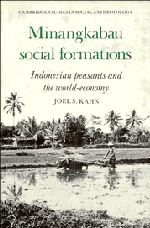Book contents
- Frontmatter
- Contents
- Lists of maps, figures and tables
- Preface
- Map
- 1 Introduction
- 2 The internal and the external in a Minangkabau village: an introduction to the world of the concrete
- 3 Adat, kinship and marriage: the constitution of the subsistence community
- 4 Agriculture and subsistence: the reproduction of the subsistence community
- 5 Commodity production in the village economy: the case of blacksmithing
- 6 Occupation, class and the peasant economy
- 7 The structure of petty commodity production
- 8 Mercantilism and the evolution of ‘traditional’ society
- 9 The emergence of petty commodity production
- 10 Conclusions: The concept of a neo-colonial social formation
- Bibliography
- Glossary of Minangkabau terms
- Index
- CAMBRIDGE STUDIES IN SOCIAL ANTHROPOLOGY
4 - Agriculture and subsistence: the reproduction of the subsistence community
Published online by Cambridge University Press: 29 September 2009
- Frontmatter
- Contents
- Lists of maps, figures and tables
- Preface
- Map
- 1 Introduction
- 2 The internal and the external in a Minangkabau village: an introduction to the world of the concrete
- 3 Adat, kinship and marriage: the constitution of the subsistence community
- 4 Agriculture and subsistence: the reproduction of the subsistence community
- 5 Commodity production in the village economy: the case of blacksmithing
- 6 Occupation, class and the peasant economy
- 7 The structure of petty commodity production
- 8 Mercantilism and the evolution of ‘traditional’ society
- 9 The emergence of petty commodity production
- 10 Conclusions: The concept of a neo-colonial social formation
- Bibliography
- Glossary of Minangkabau terms
- Index
- CAMBRIDGE STUDIES IN SOCIAL ANTHROPOLOGY
Summary
If an economic structure functions to produce and reproduce the material conditions of social existence, then an economy is not simply a technological phenomenon. Rather the economy serves to combine labour, techniques and means of production in order to reproduce a society's material base. In the previous chapter we saw that Minangkabau peasant society is reproduced, in part, through the subsistence cultivation of rice, and that this depends upon the constitution of a subsistence community through the ideology of adat, and through certain specific social structures. In this chapter I want to look in more detail at the degree to which subsistence production fulfils these functions, the ways in which the community serves to organise the techniques of rice cultivation, and the proportion of socially defined subsistence needs met through the cultivation of irrigated rice.
In spite of its declining importance as a mode of subsistence, subsistence agriculture remains an important feature of village life. Blacksmiths, seamstresses, traders and others spend some of their time working the land. Many owe their position to income derived from cash cropping, to a lump sum of cash obtained from pawning or selling land, or to the advantage gained from the fact that a proportion of their subsistence is derived directly from rice cultivation. Land is, in a sense, a mark of social existence. To possess it is to be a member of the village community. Land ownership is a form of insurance.
- Type
- Chapter
- Information
- Minangkabau Social FormationsIndonesian Peasants and the World-Economy, pp. 58 - 74Publisher: Cambridge University PressPrint publication year: 1980



